reset Oldsmobile Aurora 1998 s User Guide
[x] Cancel search | Manufacturer: OLDSMOBILE, Model Year: 1998, Model line: Aurora, Model: Oldsmobile Aurora 1998Pages: 380, PDF Size: 19.75 MB
Page 146 of 380

When the trip is complete a chime will sound and the
display will show:
TRIP
COMPLETE
The trip complete message will go off when you
press any button,
or when you turn your ignition off,
then on. The display returns to the mode displayed
prior to the interruption.
Elapsed Time (ET)
When the ignition is on, the DIC can be used as a
stopwatch. The display will show hours and minutes.
The elapsed time indicator will record up to
100 hours,
then it will reset to zero and continue counting. Press
ET, and the display will show the amount of time that
has elapsed since the elapsed time indicator was last
reset (not including time the ignition is off), such
as:
01:OS ELAPSED TIME
To reset elapsed time to zero, press RESET while the
elapsed time
is displayed.
Date
Press DATE to display the date. To change the date,
press DATE then RESET. The following display
will appear:
MONTH? XX/DD/YY
MM,
DD and YY represent the month, date and year
you currently have
in your system. Check to make sure
your clock is in the correct AM or PM mode.
Notice that each key has a number. Push the key
to
enter the number. The first XX’s will flash until you
enter the first digit for the month. You don’t need to
enter the leading zero
if the number is under 10. Press
ENTER after you’ve entered the month. The display will change to:
DAY? MM/XX/YY
Set the day just
as you set the month. After the day entry
is made, press ENTER and the display will change to:
YEAR? MM/DD/XX
2-80
Page 163 of 380

P SCAN: Press SCAN for more than two seconds: and
P SCAN will appear on the display. The radio will go to
the first preset station stored on your pushbuttons, stop
for a few seconds, then go on to the next preset station.
Press SCAN again to stop scanning.
Setting the Tone
BASS:
Press this knob lightly so it extends. Turn the
knob to increase or decrease bass. When you use this
control, the radio’s tone setting will switch to manual.
(The radio’s tone setting will not switch to manual on
the Bose radio.)
TREB: Press this knob lightly so it extends. Then pull
the knob all the way out. Turn the
knob to increase or
decrease treble. When you use this control, the radio’s
tone setting will switch to manual. (The radio’s
tone
setting will not switch to manual on the Bose radio.) If a
station is weak or noisy, you may want to decrease
the treble.
Push these knobs back into their stored positions when
you’re
not using them.
TONE: This feature allows you to choose preset bass
and treble equalization settings designed for jazz, vocal,
pop, rock and classical stations. JAZZ will appear on the
display when you first press TONE. Each time you press
it, another setting will appear on the display. Press it
again after CLASSIC appears and MANUAL will
appear. Tone control will return to the BASS and TREB
knobs. Also, if you use the BASS and TREB knobs,
control will return to them and MANUAL will appear.
(This button is
not available on the Bose radio.)
Adjusting the Speakers
BAL:
Press this knob lightly so it extenas.
Turn the knob to move the sound to the left or right
speakers. The middle position balances the sound
between the speakers.
FADE: Press the knob lightly so it extends. Then pull
the knob all the way out. Turn it to move the sound to
the front or rear speakers. The middle position balances
the sound between the speakers.
Push these knobs back into their stored positions when
you’re not using them.
Page 166 of 380

CLN: If this message appears on the display, the
cassette tape player needs to be cleaned. It will still play
tapes, but you should clean it as soon as possible to
prevent damage to the tapes and player. See “Care
of
Your Cassette Tape Player” in the Index. After you clean
the player, press and hold EJECT for five seconds to
reset the
CLN indicator. The radio will display --- to
show the indicator was reset.
Playing
a Compact Disc
With the ignition on, insert a disc partway into the slot,
label side up. The player will pull it in and the disc
should begin playing. If you want to insert a CD when
the ignition
is off, first press EJECT or RCL.
The
CD player will play either normal-size discs or the
smaller
8 cm discs with an adapter.
Note that when the disc is inserted, CD will be
displayed. When the disc is playing, a box will appear
around CD on the display. If you select a tone setting for
your CD, it will be activated each time you play a CD.
(The tone setting function is not available
on the
Bose radio.)
As each new track starts to play, the track number will
appear in the display.
If E (error) and a number appear on the radio display
and the disc comes out, it could be that:
0 E20: The road is too rough. The disc should play
when the road is smoother.
0 E20: The disc is dirty, scratched, wet or
upside down.
E20: The air is very humid. If so, wait about an hour
and try again.
If any error occurs repeatedly or if an error can’t be
corrected, please contact your retailer.
If your radio
displays an error number, write it down and provide it to
your retailer when reporting the problem.
REV (1): Press and hold this button to quickly reverse
within a track. You will hear sound at a reduced volume.
The display will show elapsed time.
FWD (2): Press and hold this button to quickly advance
within a track. You will hear sound at
a reduced volume.
The display will show elapsed time.
RDM (5): Press this button to hear the tracks in random,
rather than sequential, order. RDM will appear
on the
display when you press this button.
3-16
Page 174 of 380
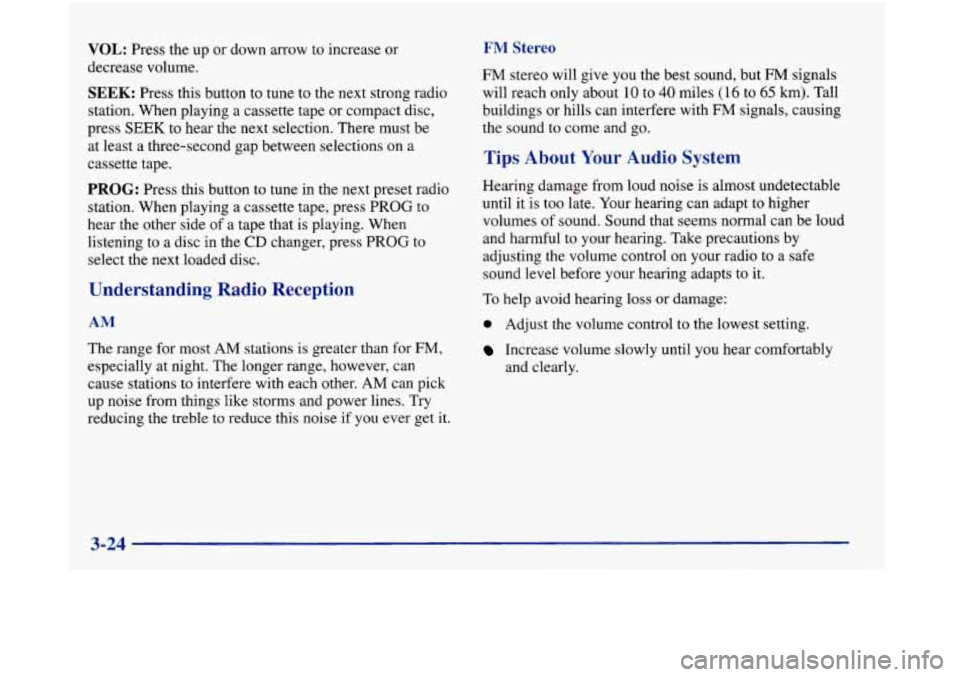
VOL: Press the up or down arrow to increase or
decrease volume.
SEEK: Press this button to tune to the next strong radio
station. When playing a cassette tape or compact disc,
press
SEEK to hear the next selection. There must be
at least a three-second gap between selections on a
cassette tape.
PROG: Press this button to tune in the next preset radio
station. When playing a cassette tape, press PROG to
hear the other side of a tape that is playing. When
listening to
a disc in the CD changer, press PROG to
select the next loaded disc.
Understanding Radio Reception
AM
The range for most AM stations is greater than for FM,
especially at night. The longer range, however, can
cause stations
to interfere with each other. AM can pick
up noise from things like storms and power lines. Try
reducing the treble to reduce this noise if
you ever get it.
FM Stereo
FM stereo will give you the best sound, but FM signals
will reach only about
10 to 40 miles (16 to 65 km). Tall
buildings or hills can interfere with
FM signals, causing
the sound to come and go.
Tips About Your Audio System
Hearing damage from loud noise is almost undetectable
until it
is too late. Your hearing can adapt to higher
volumes of sound. Sound that seems normal can be loud
and harmful to your hearing. Take precautions by
adjusting the volume control on your radio
to a safe
sound level before your hearing adapts to it.
To help avoid hearing
loss or damage:
0 Adjust the volume control to the lowest setting.
Increase volume slowly until you hear comfortably
and clearly.
3-24
Page 175 of 380
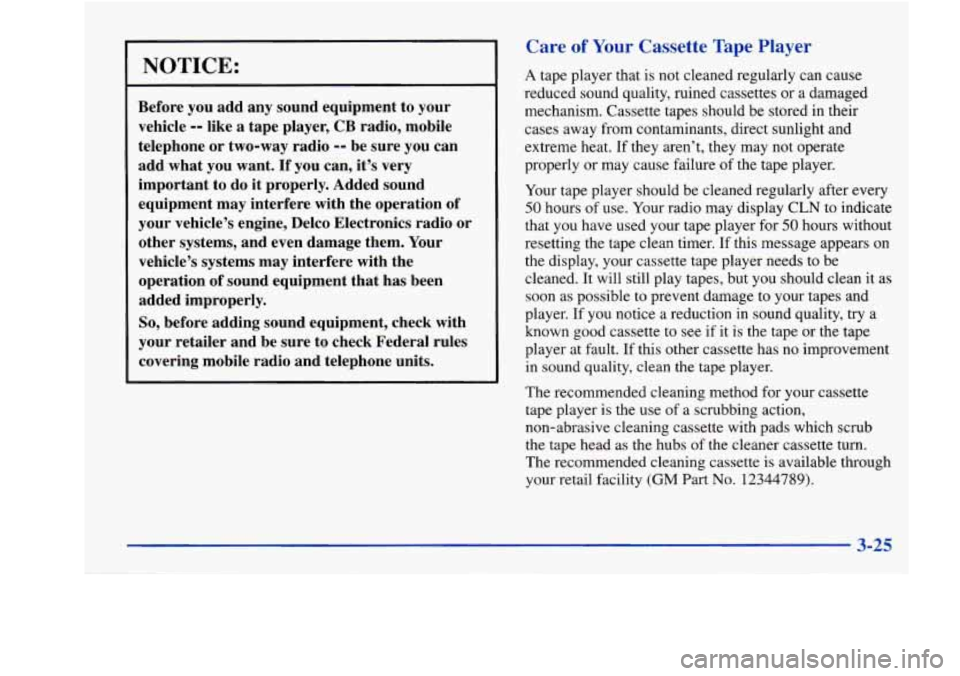
NOTICE:
Before you add any sound equipment to your
vehicle
-- like a tape player, CB radio, mobile
telephone or two-way radio
-- be sure you can
add what you want.
If you can, it’s very
important to do it properly. Added sound
equipment may interfere with the operation of
your vehicle’s engine, Delco Electronics radio or
other systems, and even damage them. Your
vehicle’s systems may interfere with the
operation of sound equipment that has been
added improperly.
So, before adding sound equipment, check with
your retailer and be sure to check Federal rules
covering mobile radio and telephone units.
Care of Your Cassette Tape Player
A tape player that is not cleaned regularly can cause
reduced sound quality, ruined cassettes or a damaged
mechanism. Cassette tapes should be stored in their
cases away from contaminants, direct sunlight and
extreme heat. If they aren’t, they may not operate
properly or may cause failure of the tape player.
Your tape player should be cleaned regularly after every
50 hours of use. Your radio may display CLN to indicate
that you have used your tape player for
50 hours without
resetting the tape clean timer. If this message appears on
the display, your cassette tape player needs to be cleaned. It will still play tapes, but you should clean it as
soon as possible to prevent damage to your tapes and
player. If you notice a reduction in sound quality, try a
known good cassette to see if
it is the tape or the tape
player at fault. If this other cassette has no improvement
in sound quality, clean the tape player.
The recommended cleaning method for your cassette
tape player is the use of a scrubbing action,
non-abrasive cleaning cassette with pads which scrub
the tape head as the hubs of the cleaner cassette turn.
The recommended cleaning cassette is available through
your retail facility
(GM Part No. 12344789).
3-25
Page 176 of 380
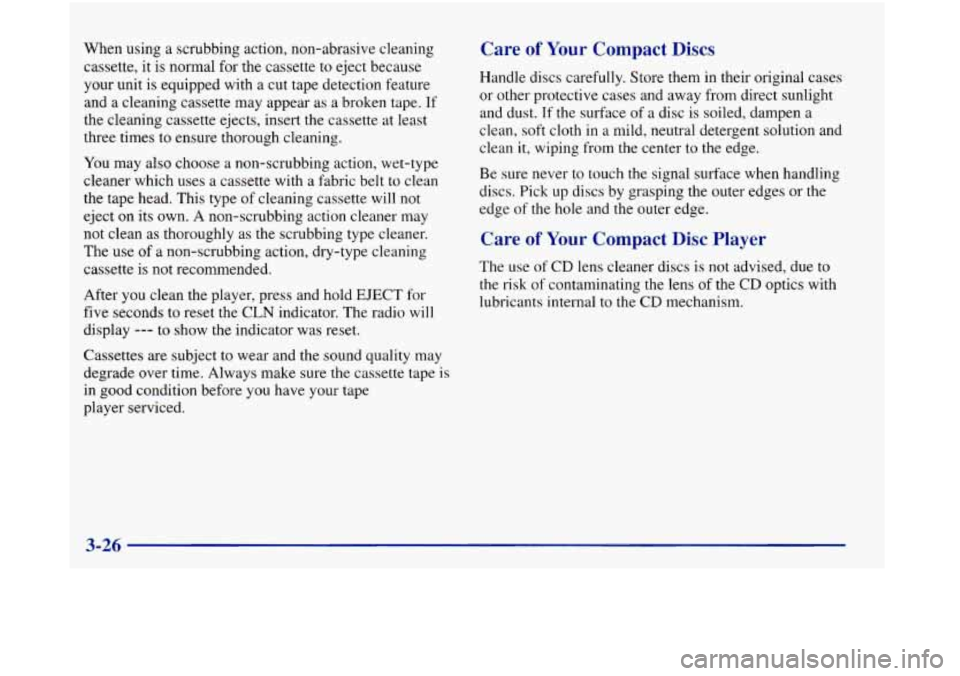
When using a scrubbing action, non-abrasive cleaning
cassette, it is normal for the cassette to eject because
your unit is equipped with a cut tape detection feature
and a cleaning cassette may appear as a broken tape. If
the cleaning cassette ejects, insert the cassette at least
three times to ensure thorough cleaning.
You may also choose a non-scrubbing action, wet-type
cleaner which uses a cassette with a fabric belt to clean
the tape head. This type of cleaning cassette will not
eject on its own.
A non-scrubbing action cleaner may
not clean as thoroughly as the scrubbing type cleaner.
The
use of a non-scrubbing action, dry-type cleaning
cassette is not recommended.
After you clean the player, press and hold EJECT for
five seconds to reset the CLN indicator. The radio will
display
--- to show the indicator was reset.
Cassettes are subject to wear and the sound quality may
degrade over time. Always make sure the cassette tape
is
in good condition before you have your tape
player serviced.
Care of Your Compact Discs
Handle discs carefully. Store them in their original cases
or other protective cases and away from direct sunlight
and dust.
If the surface of a disc is soiled, dampen a
clean, soft cloth in a mild, neutral detergent solution and
clean it, wiping from the center to the edge.
Be sure never to touch the signal surface when handling
discs. Pick up discs by grasping the outer edges
or the
edge
of the hole and the outer edge.
Care of Your Compact Disc Player
The use of CD lens cleaner discs is not advised, due to
the risk of contaminating the lens of the CD optics with
lubricants internal to the
CD mechanism.
3-26
Page 230 of 380
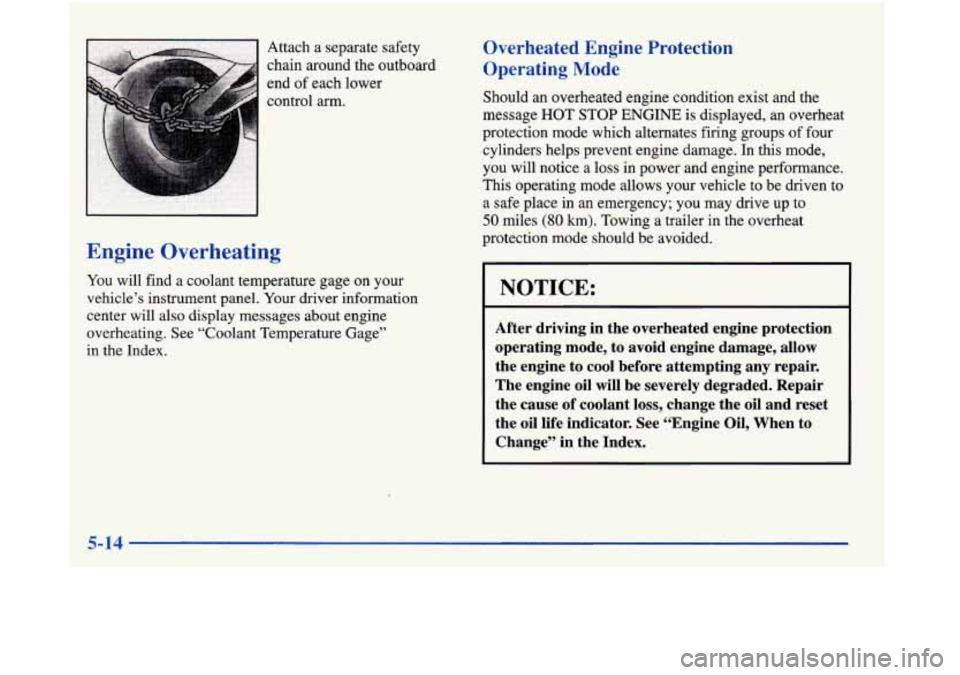
Engine Overheating
Attach a separate safety
chain around the outboard
end of each lower
control
arm.
You will find a coolant temperature gage on your
vehicle’s instrument panel. Your driver information
center will also display messages about engine
overheating. See “Coolant Temperature Gage”
in the Index.
Overheated Engine Protection
Operating Mode
Should an overheated engine condition exist and the
message HOT
STOP ENGINE is displayed, an overheat
protection mode which alternates firing groups of four
cylinders helps prevent engine damage. In this mode,
you will notice a loss in power and engine performance.
This operating mode allows your vehicle to be driven to
a safe place in an emergency; you may drive up to
50 miles (80 km). Towing a trailer in the overheat
protection mode should be avoided.
NOTICE:
After driving in the overheated engine protection
operating mode, to avoid engine damage, allow
the engine to cool before attempting any repair.
The engine oil will be severely degraded. Repair
the cause
of coolant loss, change the oil and reset
the oil life indicator. See “Engine Oil, When to
Change” in the Index.
5-14
Page 266 of 380
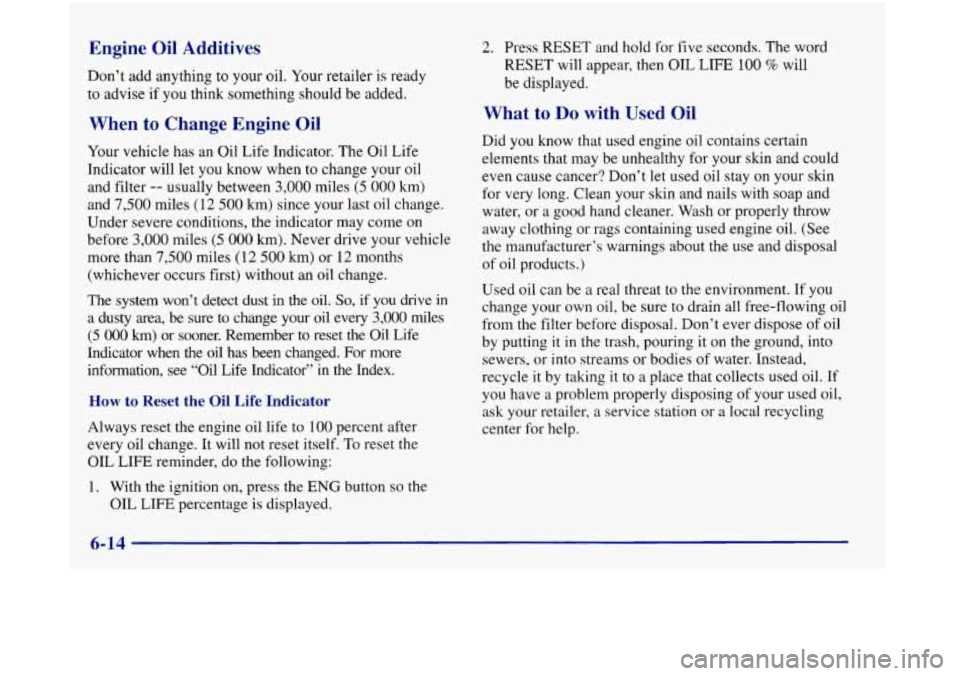
Engine Oil Additives
Don’t add anything to your oil. Your retailer is ready
to advise if you think something should be added. 2. Press
RESET and
hold for five seconds. The word
RESET will appear, then OIL LIFE 100 % will
be displayed.
When to Change Engine Oil
Your vehicle has an Oil Life Indicator. The Oil Life
Indicator will let you know when to change your oil
and filter
-- usually between 3,000 miles (5 000 km)
and
7,500 miles (12 500 km) since your last oil change.
Under severe conditions, the indicator may come on
before
3,000 miles (5 000 km). Never drive your vehicle
more than
7,500 miles (12 500 km) or 12 months
(whichever occurs first) without an oil change.
The system won’t detect dust in the oil. So, if you drive in
a dusty area, be sure to change your oil every 3,000 miles
(5 000 km) or sooner. Remember to reset the Oil Life
Indicator when the oil has been changed. For more
information, see “Oil Life Indicator” in the Index.
How to Reset the Oil Life Indicator
Always reset the engine oil life to 100 percent after
every oil change.
It will not reset itself. To reset the
OIL LIFE reminder, do the following:
1. With the ignition on, press the
ENG button so the
OIL LIFE percentage
is displayed.
What to Do with Used Oil
Did you know that used engine oil contains certain
elements that may be unhealthy for your
skin and could
even cause cancer? Don’t let used oil stay on your skin
for very long. Clean your skin and nails with soap and
water, or a good hand cleaner. Wash or properly throw
away clothing or rags containing used engine oil. (See
the manufacturer’s warnings about the use and disposal
of oil products.)
Used oil can be a real threat to the environment. If you
change your own oil, be sure to drain all free-flowing oil
from the filter before disposal. Don’t ever dispose of oil
by putting
it in the trash, pouring it on the ground, into
sewers, or into streams or bodies of water. Instead,
recycle it by taking it to a place that collects used oil. If
you have a problem properly disposing of your used oil,
ask your retailer, a service station or a local recycling
center for help.
6-14
Page 277 of 380
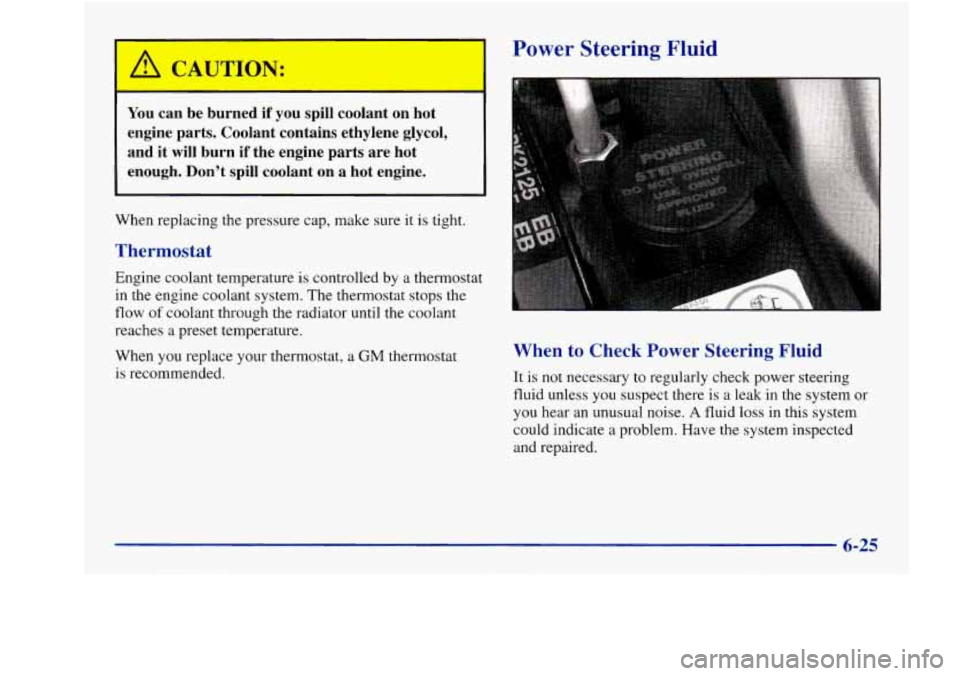
A CAUTION:
You can be burned if you spill coolant on hot
engine parts. Coolant contains ethylene glycol,
and it
will burn if the engine parts are hot
enough. Don’t spill coolant on a hot engine.
11
Power Steering Fluid
I I I
When replacing the pressure cap, make sure it is tight.
Thermostat
Engine coolant temperature is controlled by a thermostat
in the engine coolant system. The thermostat stops the
flow
of coolant through the radiator until the coolant
reaches a preset temperature.
When you replace your thermostat, a GM thermostat
is recommended.
When to Check Power Steering Fluid
It is not necessary to regularly check power steering
fluid unless you suspect there is a leak
in the system or
you hear an unusual noise.
A fluid loss in this system
could indicate a problem. Have the system inspected
and repaired.
6-25
Page 301 of 380

The grade C corresponds to a level of performance
which all passenger car tires must meet under the
Federal Motor Vehicle Safety Standard
No. 109. Grades
B and A represent higher levels of performance on the
laboratory test wheel than the minimum required by law.
Warning: The temperature grade for this tire is
established for a tire that is properly inflated and not
overloaded. Excessive speed, underinflation, or
excessive loading, either separately or in combination,
can cause heat buildup and possible tire failure.
Wheel Alignment and Tire Balance
The wheels on your vehicle were aligned and balanced
carefully at the factory to give you the longest tire life
and best overall performance.
Scheduled wheel alignment and wheel balancing are not
needed. However, if you notice unusual tire wear
or
your vehicle pulling one way or the other, the alignment
may need to be reset. If you notice your vehicle
vibrating when driving on a smooth road, your wheels
may need to be rebalanced.
Wheel Replacement
Replace any wheel that is bent, cracked, or badly rusted
or corroded. If wheel nuts keep coming loose, the wheel,
wheel bolts and wheel nuts should be replaced. If the wheel
leaks air, replace it (except some aluminum
wheels, which can sometimes be repaired). See your
retailer if any of these conditions exist.
lour retailer will know the kind of wheel you need.
Each new wheel should have the same load-carrying
capacity, diameter, width, offset and be mounted the
same way as the one
it replaces.
If you need to replace any of your wheels, wheel
bolts or wheel nuts, replace them only with new GM
original equipment parts. This way, you will be sure to
have the right wheel, wheel bolts and wheel nuts for
your Aurora model.
T' 'Y:
Using the wrong replacement wheels, wheel bolts
or wheel nuts
on your vehicle can be dangerous.
It could affect the braking and handling of your
vehicle, make your tires lose air and make you
lose control. You could have a collision in which
you or others could be injured. Always use the correct wheel, wheel bolts and wheel nuts for
replacement.